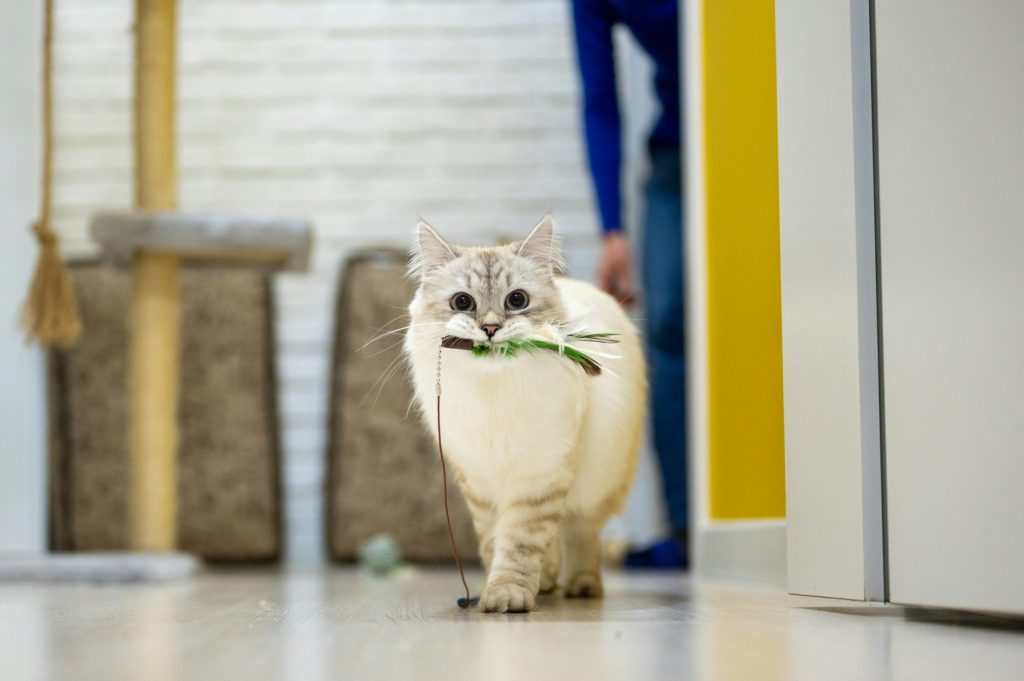
15 Simple Ways to Keep Your Indoor Cat Entertained in a Small Apartment
Living in a small apartment doesn’t mean your indoor cat has to be bored. While it’s true that felines love to explore and hunt, you don’t need a giant space or access to the outdoors to give them the stimulation they crave. With just a few thoughtful changes, you can keep your indoor cat entertained, engaged, and happy—even in tight quarters.
Whether you're working from home, juggling a busy schedule, or just want to improve your cat’s daily quality of life, these 15 ideas are easy to implement and proven to work. From DIY toys to vertical climbing zones, we’ll cover the best low-stress, apartment-friendly ways to enrich your cat’s world without adding chaos to yours.
1. Build a Window Watching Station
One of the easiest ways to keep your indoor cat entertained is by giving them a front-row seat to the world outside. Cats love watching birds, squirrels, and people go by. Set up a cozy perch near a window with a cushion, blanket, or suction-cup cat hammock.
If your apartment doesn’t have a good window ledge, consider adding a freestanding cat tree or shelf near natural light. Bonus points for adding a bird feeder outside the window—just make sure it’s placed where cats can’t knock it over!
2. Rotate Toys Regularly to Prevent Boredom
Leaving out the same toys day after day gets dull fast—even for cats. Instead of overwhelming your space with dozens of options, keep a small selection of toys in rotation. Every few days, swap them out to keep things fresh and exciting.
This doesn’t have to be complicated. Store toys in a small bin or drawer and alternate different textures like crinkle balls, wand toys, plush mice, or kickers. Even toys your cat hasn’t touched in weeks can feel brand new when reintroduced in a new context.
3. Create a Cat TV Setup
Believe it or not, many cats enjoy watching TV—especially if it includes birds, fish, or small critters moving around. YouTube is filled with dedicated cat entertainment channels that loop calming, interactive visuals designed just for felines.
Set up a screen at your cat’s eye level, either on a low shelf or TV stand, and let them “hunt” safely indoors. Just be sure the screen is stable and cords are tucked away to avoid chewing or tipping accidents.
4. Set Up a DIY Puzzle Feeder
Mental stimulation is just as important as physical play. Puzzle feeders turn mealtime into a fun challenge and help satisfy your cat’s natural foraging instincts. You can buy commercial puzzle toys or make your own with toilet paper rolls, muffin tins, or cardboard boxes.
Start simple and gradually make puzzles more challenging as your cat gets the hang of it. This is an excellent way to slow down fast eaters while keeping your indoor cat entertained during solo hours.
5. Use Catnip, Silvervine, or Valerian Root Toys
Many cats respond to certain plant compounds that naturally boost playfulness. Catnip is the most famous, but silvervine and valerian root are great alternatives for cats that don’t react to catnip. Rotate these scented toys a couple of times per week to keep the novelty alive.
These natural stimulants are a great way to help your cat release energy in a controlled, enriching way—especially useful if your space limits running or jumping. Just watch for overstimulation and let your cat decide when they’ve had enough.
6. Install Vertical Climbing and Perch Spaces
Cats love to be up high—it makes them feel secure and allows them to survey their environment. In small apartments, vertical space becomes your best friend. Wall-mounted shelves, tall cat trees, or even cleared-off bookcases can offer perfect perches.
These elevated areas help reduce stress, increase exercise, and provide solo relaxation zones. Just make sure all fixtures are sturdy and safe for repeated use. A multi-level space makes even the tiniest studio feel like a playground to your cat.
7. Play Interactive Games With Your Cat Daily
The best enrichment isn’t just passive—it’s social. Spending even 10–15 minutes each day actively playing with your cat helps reduce stress, build trust, and burn off excess energy. Wand toys, laser pointers, and feather teasers are all great options.
Try to vary your play style each day. Use fast, unpredictable movements to mimic prey and let your cat “catch” the toy occasionally. These brief sessions are especially important in small apartments where solo exercise options are limited.
8. Try Hide-and-Seek Treat Hunts
Encourage your cat’s natural hunting instincts by hiding a few treats around the apartment. Place them under furniture, behind doors, or inside cardboard boxes to make discovery fun and rewarding. You can even use small portions of their daily kibble to avoid overfeeding.
This simple activity adds excitement to an otherwise predictable space. Just be sure to rotate hiding spots regularly and keep track of uneaten treats to prevent spoilage or pests.
9. Offer Scratchers in Different Textures and Locations
Scratching is a vital outlet for stress, scent marking, and nail health. Instead of just one vertical post in the corner, try offering a variety of scratchers around your apartment—horizontal pads, angled ramps, or cardboard loungers all count.
Place scratchers in high-traffic areas or near nap zones to increase usage. If your cat’s ignoring them, try sprinkling catnip or placing toys nearby. Rotating locations or replacing worn ones can reignite interest.
10. Provide a Cat-Safe Balcony or Window Enclosure
If your apartment has a balcony, consider turning it into a mini catio with secure netting or fencing. For window lovers, you can install window boxes or secure mesh screens that allow your cat to get fresh air without risking escape.
These spaces stimulate the senses with natural light, airflow, and outdoor smells—especially valuable in apartments where nature is otherwise limited. Always supervise initial sessions to ensure your setup is escape-proof.
11. Offer Enrichment Through Scent and Sound
Cats experience the world through their senses, so mixing in gentle enrichment through scent and sound can make their space more interesting. Use calming feline pheromones or herbal sachets (like chamomile or lavender) in cat-safe zones.
You can also play cat-specific music, nature sounds, or soft classical playlists to create a relaxing background. This is especially useful if your cat is alone during the day or easily startled by city noise.
12. Follow a Daily Routine With Variety
Routine gives cats a sense of security, but small variations keep it from feeling dull. Feed meals, clean litter, and schedule playtime around the same hours each day, then add little surprises like a new toy, a fresh cardboard box, or a 5-minute feather chase at random times.
Structured spontaneity—yes, it’s a thing—helps prevent behavioral issues and keeps your indoor cat engaged. A little novelty goes a long way when your world is confined to a few rooms.
13. Build Vertical Climbing Opportunities
Cats love to climb, perch, and survey their surroundings from above. In an indoor environment, vertical enrichment helps them feel confident and reduces boredom. Install cat shelves, bookcase paths, or a tall tree near windows.
If you’re tight on space, even a multi-level cat tower or mounted perch can give your cat a much-needed “king of the castle” view. Just be sure the setup is stable and secure.
14. Teach Simple Clicker Training Tricks
Yes—cats can be trained! Using a clicker and tiny treats, you can teach your indoor cat to come when called, high-five, sit, spin, or jump through a hoop. It’s mentally stimulating and a great bonding activity.
Start with very short sessions and reward generously. Many cats find training empowering and exciting, especially those with high energy or a strong food drive.
15. Use Video Enrichment While You're Away
When you’re not home, video content designed for cats—like birds, squirrels, or fish—can hold your pet’s attention. Play it on a tablet or TV screen set at eye level, or use a pet cam that lets you check in and talk to your cat.
Some cats love it, others ignore it—so test and observe. Just remember to leave screens out of reach if your cat tends to swat or knock things over!
Final Thoughts
Keeping your indoor cat entertained isn’t about expensive gadgets or constant supervision—it’s about creating a living space that taps into their instincts. With the right balance of routine, enrichment, and interaction, even small apartments can feel like a feline paradise.
Every cat is different, so don’t worry if it takes some trial and error to find their favorite activities. The key is consistency, variety, and observing what truly engages your cat. With just a few intentional changes, you’ll boost their happiness—and your bond—in the process.
Frequently Asked Questions
How do I keep my indoor cat from getting bored?
Use a mix of physical toys, window perches, puzzle feeders, and interactive play. Rotate toys weekly and schedule daily play sessions to keep your cat engaged and mentally stimulated.
What are the best toys to keep an indoor cat entertained?
Wand toys, feather teasers, puzzle feeders, catnip mice, and cardboard tunnels are all excellent. You can also get creative with household items like paper bags or tissue boxes.
Can a cat be happy living indoors only?
Absolutely—indoor cats can be just as happy as outdoor ones if their environment meets their physical and emotional needs. Enrichment, routine, and attention are key.
How much daily playtime does my indoor cat need?
Most cats benefit from at least two 10–15 minute play sessions per day. High-energy cats or kittens may need more. Watch your cat’s behavior to guide your routine.
What’s the easiest way to enrich a small apartment for cats?
Use vertical space like cat trees or shelves, rotate toys, and give your cat access to window views. Small touches like new scents or textures also help break the monotony.

Join the Busy Pet Parent Newsletter!
Get easy routines, time-saving tips, and the latest gear reviews—delivered straight to your inbox.
Perfect for busy pet owners, apartment dwellers, and anyone who wants a happy, healthy companion (without the stress).
Exclusive guides & checklists
Product recommendations & deals
No spam—unsubscribe anytime!




